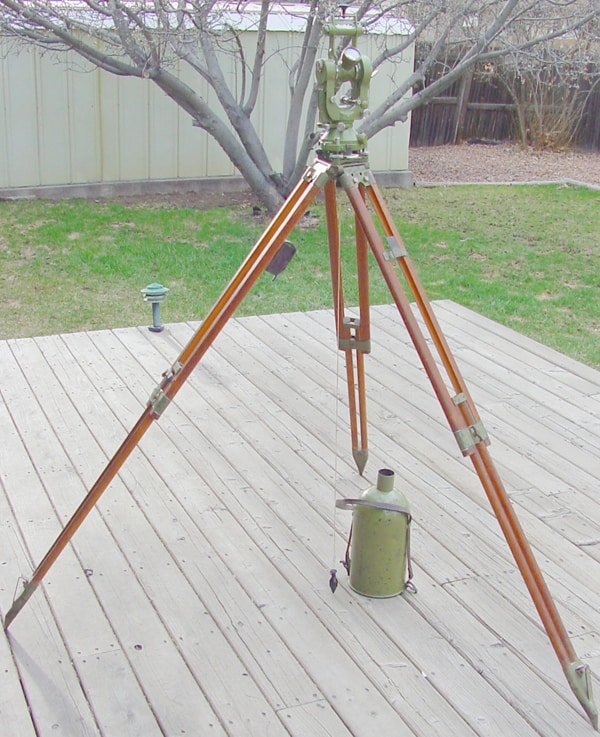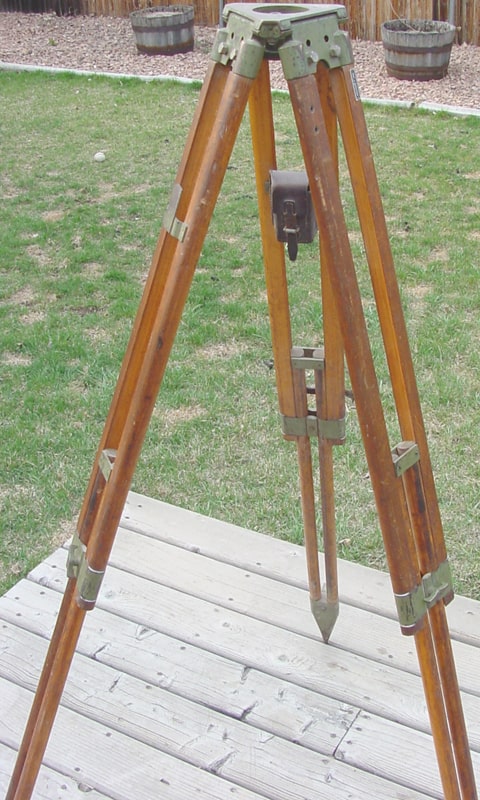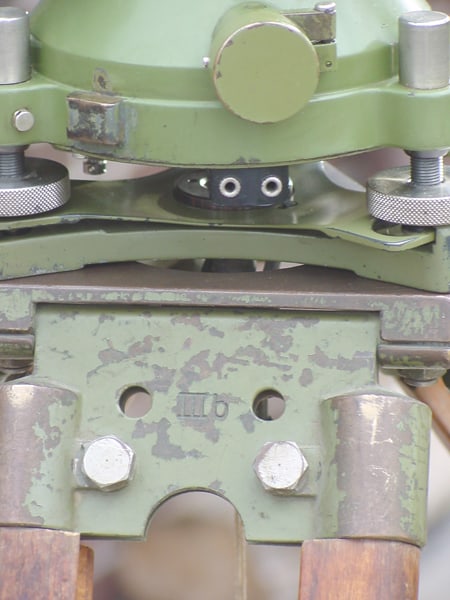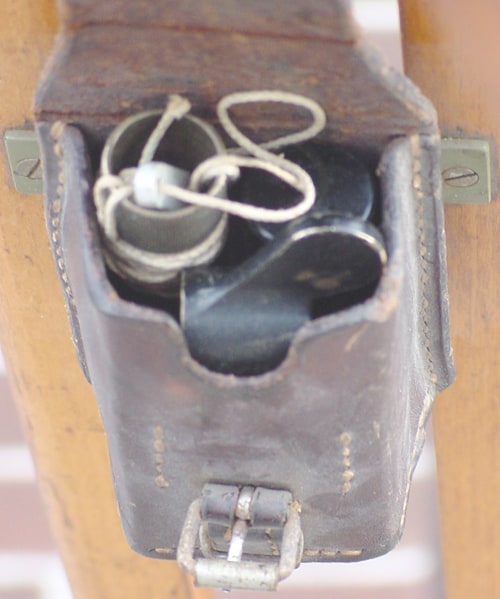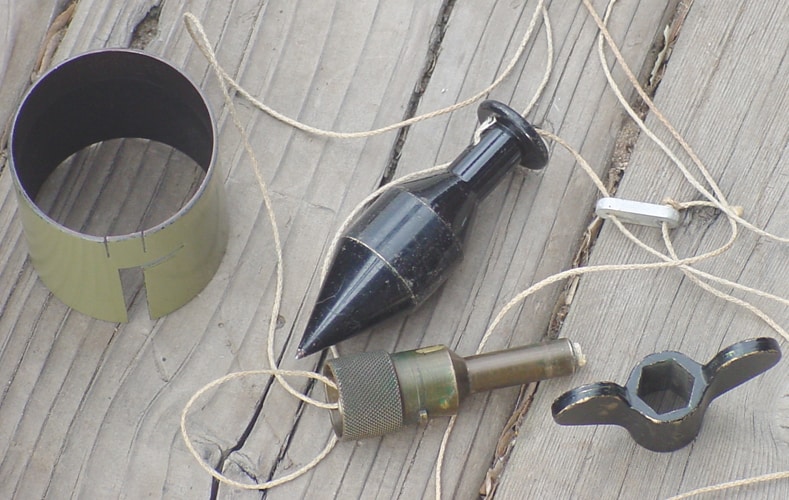I thought this link belonged here
570 responses on redditt
Sweet!
Mr. Dyer's survey gear was Wild Heerbrugg based on all those green boxes. The instrument looks like an old Wild T-2 mounted on a Wild Heerbrugg P-30 terrestrial camera. Supposedly Wild made less than 300.
Here's a photo and description for a Wild P-30 photo-theodolite (ser. no. 187, circa 1950) courtesy of The University of New South Wales in Sydney.
I know that Radu graduated from Adelaide University, but he probably visited his mates in Sydney.
Wild T2 FTW.
Great photo for a grandson to have. That tripod is the older one I referred to on the post on 05/28/17 wondering about old Wild tripods. Since I wasn't around surveying when it happened, I wonder when Wild started painting them.
I notice the plumb bob about a foot and a half above ground level (and presumably above the mark). Is that as low as it got, or was it just stowed that way during measurement? If that's as low as it got the centering error must have been rather large by today's standards. And the target, an example of which is lying in the background, is not exactly pinpoint. I do understand that the sight lengths were maybe 20 miles, and so these things are not so important overall.
Mark Mayer, post: 431071, member: 424 wrote: I notice the plumb bob about a foot and a half above ground level (and presumably above the mark). Is that as low as it got, or was it just stowed that way during measurement? If that's as low as it got the centering error must have been rather large by today's standards. And the target, an example of which is lying in the background, is not exactly pinpoint. I do understand that the sight lengths were maybe 20 miles, and so these things are not so important overall.
I'm like you. That's the first time I've seen a vertical target like that one. It must have worked though because the wind can be a mighty presence at times up there.
I can give you some insight on the plumb bob. You'll note a knot of sorts in the cord about 6 inches above the actual bob. It's either the little jig provided by the manufacturer in the accessories that came with the instrument, or a slip knot affair. The plumb bob can be lowered or adjusted down when the instrument is being set up; then raised to get it out of the way of either a chainman or the gunner's own boots.
I was more familiar with the slip-knot probably because of the age of all the instruments I used. The original accessories were usually pretty much gone or broken. I don't know what you call the little H shaped jig the plumb bob cord was wound on, I just called it a jig. But older ones had a slot cut to use as a slip knot to raise and lower the plumb bob with precision.
Edit: Looking at the size of the plumb bob it must not have been very windy that day...
Awesome
I used to collect old Wild instruments. This is a 1940 vintage T2 with striding level and tripod. The tripod is the Wild IIIb model, which included a small leather pouch to keep the tiny plumb bob and a wrench to snug up the tripod legs. The plumb bob got you close and then the optical plummet in the non-detachable tribrach got you over the point
I'd suggest he'd pulled the plumbob back up out of kicking way.
That's what I did.
In Gene's last photo the plumbob has an adjustment gizmo on the string which you can see is nearly at the bottom of the string in the old photo.
That means the plumbob has been pulled back up and isn't fully extended.
In that mode (extended to the ground) the aluminium gizmo would be higher up.
I can't see it in the photo above but maybe it's right up at the top where it fits into the socket under the head of the legs?
Someone no doubt will have a proper word for that 'aluminium gizmo' 🙂
nice!! I've never seen the red/white canvas frame that's laying on the ground there. I assume that's for triangulation during the day?
P.S. If you click on the photo of Mr. Dyer and zoom in you will see the leather pouch on the left tripod leg is camouflaged by the Buckskin's mane. Those USGS guys had the bestest equipment, although, I'm not sure I'd want to be up on that ridge line with a string of ponies and those thunder clouds swirling about. Might be that wearing a high X hat acts as a better "insulator".
Richard, "aluminium gizmo" works for me with the possible exception of the extra "i". 😉
Gene Kooper, post: 431176, member: 9850 wrote: .... although, I'm not sure I'd want to be up on that ridge line with a string of ponies and those thunder clouds swirling about.... 😉
I'm sure the USGS crews had good horses underneath them up in the high country. 😉
It's been a number of years, but I was talked into taking my sister on this horseback ride across the divide:
http://www.sombrero.com/adventures/continental-divide-ride/
The horses were some of the most sure-footed and well behaved animals I had ever been around. Talking with the hands that managed the ride I learned their horses included a number of lead horses and a well-defined trail order. And yes, there are some horses that have no business in rough terrain.
While I occasionally ride, my sister hadn't been on a horse in 40 years. 8 or 9 hours in the saddle with no level ground in the entire county will give anybody the worst case of "saddle ass" known to man.
Monte and his crew out in Presidio County has my sincere respect and admiration.
I wouldn't be worried about the horse I was riding up there, paden. Rather the riding of an animal with iron shoes when the afternoon thunder storm rolls in. A woman and her horse were killed southwest of metro Denver last month by lightning from a quick moving thunderstorm. The woman's niece that was riding double with her is still convalescing.
I like the fact that the cost of the Continental Divide ride includes the use of a raincoat!
You are right about the lightning. Down here in OK the local weather channel shows us the wind gusts recorded around the state. When I'm with family in CO the local weather shows the lightning strikes recorded that afternoon.
Gene Kooper, post: 431176, member: 9850 wrote: Richard, "aluminium gizmo" works for me with the possible exception of the extra "i".
American spelling.
Actually it has something to do with the refining. Ours is more refined that's why it has the extra" i". 🙂
